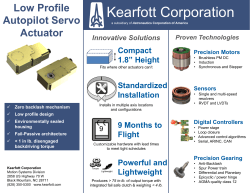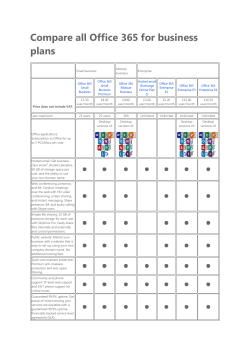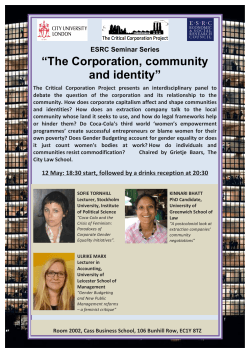
SLEAK: - Welcome to ECE at WPI
|1| SLEAK: A Side-channel Leakage Evaluator and Analysis Kit Dan Walters Andrew Hagen Eric Kedaigle WPI Applied Cryptology Seminar March 2015 This technical data was produced for the U.S. Government under Contract No. FA8702-14-C-0001, and is subject to the Rights in Technical Data-Noncommercial Items Clause (DFARS) 252.227-7013 (NOV 1995) Approved for Public Release; Distribution Unlimited. Case Number 14-3463. © 2014 The MITRE Corporation. All rights reserved. |2| Agenda Background / Motivation – Need for automated side-channel vulnerability analysis Technical Approach Proof of concept – Experimental results – Countermeasure analysis Conclusion © 2014 The MITRE Corporation. All rights reserved. Approved for Public Release; Distribution Unlimited. Case Number 14-3463. |3| Background Side-channel attacks (SCA) present a major threat to secure embedded systems – Widely demonstrated over the last 15 years – Timing, instantaneous or static power consumption, electromagnetic radiation, others yet to be discovered… Software countermeasures known in theory, but difficult to implement properly – Requires expertise in side-channel and crypto – Unexpected compiler transformations – Platform-specific leakage sources All countermeasures must be empirically verified for effectiveness © 2014 The MITRE Corporation. All rights reserved. Approved for Public Release; Distribution Unlimited. Case Number 14-3463. |4| SCA Testing Challenges Expensive and slow – Side-channel collection equipment – Instrumentation for each target hardware platform – Expertise to collect and analyze data Results are often inconsistent – affected by several parameters: – Skill and experience of tester/attacker – Choice of side-channel – Environmental conditions (e.g. temperature and background noise) – Data-collection equipment – Analysis techniques (new techniques constantly emerging) Performed near the end of development cycle Difficult to isolate effects of individual countermeasures © 2014 The MITRE Corporation. All rights reserved. Approved for Public Release; Distribution Unlimited. Case Number 14-3463. |5| Our approach Use full-system simulator to analyze target binary – Inspect intermediate states of simulator during target execution – Automate vulnerability detection Advantages – – – – – – – Analysis is automated Reduces expertise needed for tester Results are reproducible Reduces need for side-channel collection equipment Analysis is performed on actual machine code (unmodified binary) Applicable regardless of countermeasure or algorithm Does not require a complex leakage model Measure of “worst-case” information leakage – Source-code not required © 2014 The MITRE Corporation. All rights reserved. Approved for Public Release; Distribution Unlimited. Case Number 14-3463. |6| Definitions Target binary – The machine-code/executable program under evaluation – Directly analyze the unmodified binary – not required that the program is branch-free – Requires an interface for setting all inputs (and categorization of inputs) Leakage model – Specifies the observable information that leaks via side-channels – Leakage function takes state of the machine as input and returns a value or set of values that represents observable information Intermediate value – The value (or state) of some system component during the system’s execution of the target binary Trace – Set of intermediate values for a single execution of the target binary © 2014 The MITRE Corporation. All rights reserved. Approved for Public Release; Distribution Unlimited. Case Number 14-3463. |7| Definitions (cont.) Mutual Information – A measure of the mutual dependence between two random variables Perfect Masking – An intermediate value is perfectly masked if it is statistically independent of the key – The MI between the intermediate state and the key is zero Leakage Location – An intermediate value that leaks secret information MI(V,S) > 0 , for some intermediate value V and secret value S © 2014 The MITRE Corporation. All rights reserved. Approved for Public Release; Distribution Unlimited. Case Number 14-3463. |8| SLEAK – Algorithm User inputs: – Target binary – Interface to binary Secret Random Public Start by identifying intermediate values that depend on secret bits – Optional optimization Calculate MI between each intermediate value and each bit of the secret input – Empirical studies show approximation rapidly converges to true value © 2014 The MITRE Corporation. All rights reserved. Approved for Public Release; Distribution Unlimited. Case Number 14-3463. |9| SLEAK - Proof-of-concept implementation Utilizes Gem5 simulator – Approach is not tied to any particular simulator Produces large quantity of information – Calculates mutual information for each key-dependent intermediate state Visualization tools to analyze results © 2014 The MITRE Corporation. All rights reserved. Approved for Public Release; Distribution Unlimited. Case Number 14-3463. | 10 | SLEAK Views – Leakage Timeline © 2014 The MITRE Corporation. All rights reserved. Approved for Public Release; Distribution Unlimited. Case Number 14-3463. | 11 | SLEAK Views – Assembly Highlighting PC # Min Max Avg Instruction Assembly view highlighting leaking instructions © 2014 The MITRE Corporation. All rights reserved. Approved for Public Release; Distribution Unlimited. Case Number 14-3463. | 12 | Experimental Results Compared results from SLEAK to results based on side-channel measurements on physical hardware Hardware platform: – BeagleBone Rev A6 Common dev board used for hobbyist work and prototyping – 720MHz ARM Cortex-A8 Core used in many SoCs and consumer devices (e.g. smart phones) – Angstrom Linux Collection equipment – EM Side-channel – Near-field magnetic probe – 14-bit ADC 400MS/s © 2014 The MITRE Corporation. All rights reserved. Approved for Public Release; Distribution Unlimited. Case Number 14-3463. | 13 | Experimental Results – Leakage Patterns Tested with AES256 - unprotected Predicted EM Leakage implementation – Tracked number of register writes performed over a sliding time window – Same binary run on HW platform and SLEAK EM Radiation from Cortex-A8 Average Measured EM Trace strongly related to register writes – Strong indication of simulator accuracy for execution of test program – Register updates are a significant source of observed EM leakage © 2014 The MITRE Corporation. All rights reserved. Approved for Public Release; Distribution Unlimited. Case Number 14-3463. | 14 | Experimental Results – Masking Strength Tested with custom test programs – Performs s-box table lookup on secret input value – Protected with boolean masking countermeasure – Multiple versions test program, adjusted distribution of mask values EM Leakage of S-Box Lookups © 2014 The MITRE Corporation. All rights reserved. Approved for Public Release; Distribution Unlimited. Case Number 14-3463. | 15 | Experimental Results – Masking Strength Comparison with SLEAK Comparison between MI calculated with real EM measurements and MI from SLEAK using a generic leakage model © 2014 The MITRE Corporation. All rights reserved. Approved for Public Release; Distribution Unlimited. Case Number 14-3463. | 16 | Experimental Results – Masking Strength Comparison with SLEAK Comparison between MI calculated with real EM measurements and MI from SLEAK using a hamming-weight leakage model © 2014 The MITRE Corporation. All rights reserved. Approved for Public Release; Distribution Unlimited. Case Number 14-3463. | 17 | Experimental Results – Key Extraction Maximum correlation for each guess of an AES key-byte plotted against the number of traces. The correct guess is black and incorrect guesses in gray. © 2014 The MITRE Corporation. All rights reserved. Approved for Public Release; Distribution Unlimited. Case Number 14-3463. | 18 | Real-world Countermeasure Analysis Analyzed two different AES implementations with countermeasures – DPA Contest v4.1 (www.dpacontest.org) Uses Rotating S-box Masking (RSM) - a modern and sophisticated masking countermeasure (Ported for our HW platform) – Custom boolean-masked version of AES Intended to be completely secure against register-based leakage SLEAK identified unexpected vulnerabilities in both implementations © 2014 The MITRE Corporation. All rights reserved. Approved for Public Release; Distribution Unlimited. Case Number 14-3463. | 19 | Low-Entropy Masking Schemes Rotating S-box Masking is a “low-entropy masking scheme” – Number of discrete mask values is less than number of possible intermediate values that it protects RSM uses 16 mask values (4 bits of entropy), while it is used to protect 8-bit intermediate values – Trade-off between security and performance Reduced entropy allows for more efficient implementations SLEAK detected several leakage locations due to low-entropy – Not surprising – Easy to ignore locations with an “acceptable” level of leakage © 2014 The MITRE Corporation. All rights reserved. Approved for Public Release; Distribution Unlimited. Case Number 14-3463. | 20 | Mask Cancellation from Register Updates Register updates are commonly a major source of side-channel leakage – Identified register-update vulnerability in RSM implementation Cannot be detected from static-analysis of sourcecode or IR – Register allocation occurs in compiler backend © 2014 The MITRE Corporation. All rights reserved. Approved for Public Release; Distribution Unlimited. Case Number 14-3463. | 21 | Mask Cancellation and Intrinsic Functions memcpy call is a single intrinsic function at IR level – Later compiler stage “expands” to several assembly instructions – Performance optimization loads multiple bytes into single register before storing to memory Cannot be detected from staticanalysis of source-code or IR – Lowering of intrinsic functions occurs in compiler backend Implementation of intrinsic Partial Assembly Listing for memcpy (leaking instructions highlighted in gray) functions can be significantly different across different target platforms © 2014 The MITRE Corporation. All rights reserved. Approved for Public Release; Distribution Unlimited. Case Number 14-3463. | 22 | Conclusion Propose the use of full-system simulators to analyze software for sidechannel vulnerabilities – Demonstrated technique for automated analysis SLEAK can help reduce the cost of evaluating the security of software implementations – Detects complex vulnerabilities Platform-specific leakage Vulnerabilities introduced from compiler effects – Can be used directly by cryptographic software developer Does not require physical hardware or side-channel traces Does not require expertise in side-channel analysis Testing can be performed early in the development cycle (when it is easier to fix) – Approximating mutual information is a practical approach Identified real-world cases where high-level code and IR is secure, but vulnerabilities are introduced during compiler’s final stages © 2014 The MITRE Corporation. All rights reserved. Approved for Public Release; Distribution Unlimited. Case Number 14-3463. | 23 | Questions Dan Walters (dwalters@mitre.org) © 2014 The MITRE Corporation. All rights reserved. Approved for Public Release; Distribution Unlimited. Case Number 14-3463.
© Copyright 2025










